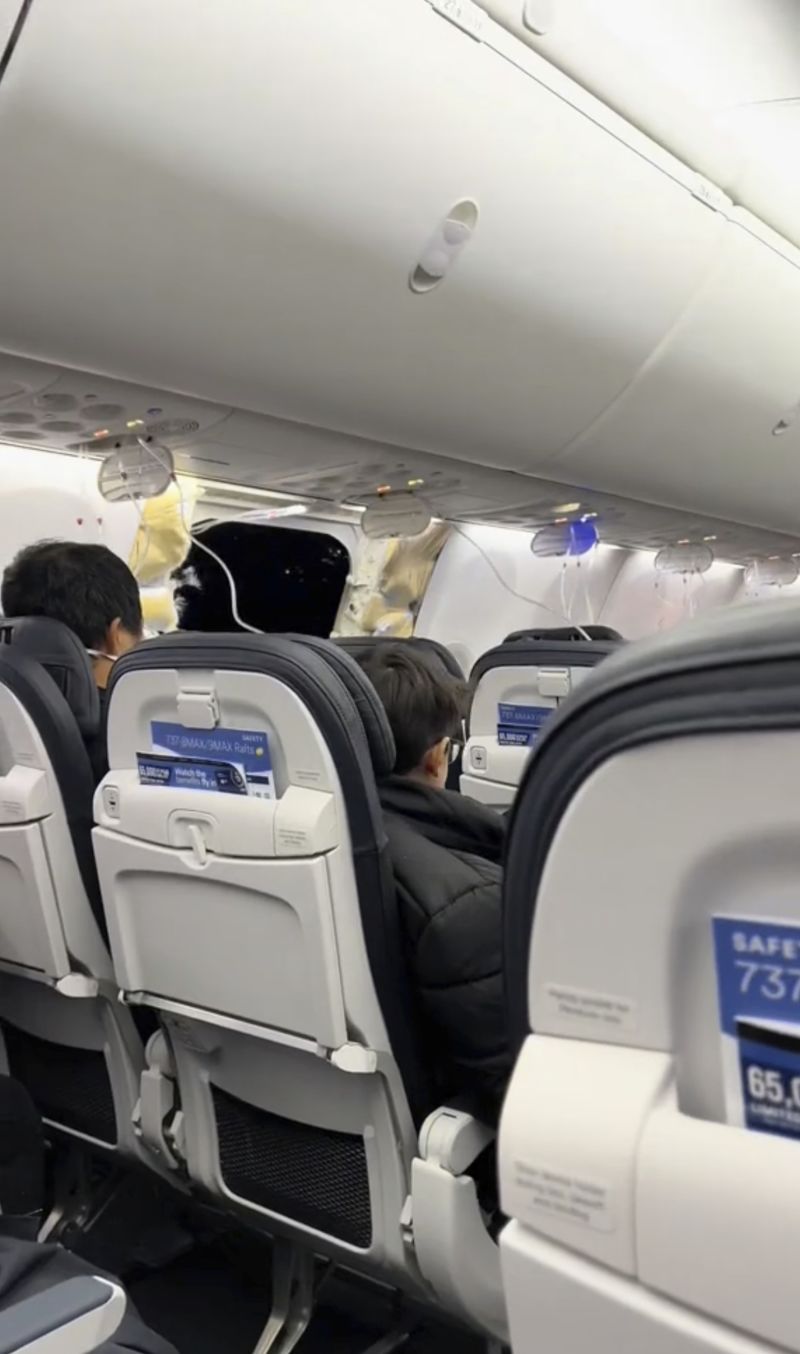
Adding to a Decade of Quality Control Challenges: 10 Minutes of Terrifying Flight Experience on Boeing

Boeing's once unparalleled reputation for safety and quality in commercial jets has taken a severe hit Recent quality problems extend beyond the infamous 737 Max, impacting their bottom line significantly
Once known for its unparalleled safety and quality in commercial jets, Boeing's reputation has taken a hit. The recent harrowing incident involving a 10-week-old 737 Max 9 flight is just the newest in a series of concerns about the safety and quality control of Boeing aircraft. Remarkably, there were no fatalities or major injuries when a part of the plane tore off mid-flight from Portland, Oregon to Ontario, California, causing some contents to be ejected into the air.
Jennifer Homendy, chair of the National Safety Transportation Board (NTSB), told CNN that it is fortunate that nobody died and there were not more serious injuries. Investigators are actively gathering and analyzing data as well as eyewitness accounts while also closely examining the aircraft itself. Early details from the NTSB are alarming: Homendy mentioned that the headrests from seat 26A, which is right next to the refrigerator-sized hole on the plane's left side, as well as seat 25A in front of it, were missing. Additionally, seat structures are twisted, oxygen masks are hanging, and a piece of clothing is stuck in the hole caused by the missing door plug that detached from the airplane.
Homendy commented on the calm appearance of the video, stating her belief that the actual situation was chaotic and loud for the passengers. The cause of the accident has yet to be determined. She also mentioned that the plane's auto pressurization fail light had lit up three times in the previous month, and it remains uncertain whether this has any connection to the incident on Friday.
United Airlines announced on Monday that loose bolts were discovered on the same part of an undisclosed number of its 737 Max 9 planes. The airline cited an installation issue as the cause of the problem.
Boeing also issued a statement, expressing their commitment to supporting operators in conducting required inspections and addressing any findings. They emphasized their dedication to ensuring all Boeing airplanes meet design specifications and the highest safety and quality standards, while regretting the impact on customers and passengers.
The debut of the Alaska Airlines plane was in October. Richard Aboulafia, managing director at AeroDynamic Advisory, an aerospace and defense management consultancy based in Michigan, suggested that the plane being essentially brand new implies that ultimately it could be Boeing's fault and not the maintenance crew at Alaska Airlines.
Passengers are seen near the damage on an Alaska Airlines Boeing 737 Max 9, Flight 1282, in this image from video provided by Elizabeth Le. The aircraft was forced to return to Portland International Airport on Friday, Jan. 5, 2024. (Elizabeth Le via AP)
Alaska Airlines emergency landing leads to grounding of Boeing 737 MAX 9 planes, causing travel disruptions and cancellations. Analyst Aboulafia said the "almost certainly not a design issue" is a small consolation for Boeing, but doesn't excuse the company.
"He stated that the production process is the most likely reason," Boeing agreed with the FAA's decision to ground all 737 Max 9 planes for inspection and has provided instructions to airlines and maintenance companies.
Boeing's main regulator, the FAA, is under heavy scrutiny for recent airline delays and close calls between planes. The agency is also criticized for allowing aircraft manufacturers too much control during the certification process.
Boeing has been dealing with quality and safety problems for five years, resulting in some jets being grounded long-term and the suspension of deliveries for others. This has led to a nearly 9% drop in Boeing's stock in premarket trading on Monday, causing concern among investors about potential further harm to the company's business.
Boeing's most significant quality issues stemmed from the design of the 737 Max, which was found to be a contributing factor in two fatal crashes - one in Indonesia in October 2018 and the other in Ethiopia in March 2019. These crashes resulted in the loss of all 346 passengers aboard the flights and forced a 20-month grounding of Boeing's top-selling jets, costing the company over $21 billion.
The design flaws that led to the crashes raised concerns about the decision-making process at Boeing. Internal communications released during the grounding revealed one employee's description of the jet as "designed by clowns, who in turn are supervised by monkeys."
Two additional workers confirmed their agreement to prohibit their relatives from traveling on the aircraft. Boeing's publication of the records contained a formal apology to the FAA, Congress, airlines, and the passengers. The company announced plans to convene a meeting for all employees on Tuesday, with a focus on safety, at the 737 Max factory in Renton, Washington. Additionally, the company issued a memo to its staff on Monday, urging them to prioritize safety by considering individual and collaborative actions that can be taken to prioritize safety and first-time quality in all areas of the business.
Quality problems go beyond 737 Max
The problems with the Max are only part of the quality control issues that have dogged the company.
Boeing had to pause deliveries of its 787 Dreamliner twice, once in 2021 and again in 2023, due to quality concerns raised by the FAA. The 777 jet also faced a grounding after an engine failure on a United flight caused engine debris to fall onto homes and the ground below.
Engine issues on the 777 were reportedly caused by Boeing's suppliers. The company has been working to reduce costs paid to suppliers, including those that manufacture its fuselages and engines. Aboulafia suggested that this cost-cutting effort may have led to the series of quality control problems with its planes.
The company declined to comment on whether the Alaska Airlines flight was connected to Boeings recent quality issues. This incident with the Alaska Airlines 737 Max flight is not the first since the plane returned to service three years ago after being grounded. In December, Boeing requested airlines to inspect all of their 737 Max jets for a potential loose bolt in the rudder system, following the discovery of a potential problem with a key part on two aircraft.
Boeing consistently reaffirms its commitment to prioritizing safety and quality whenever a new issue arises. After the Alaska Airlines accident, the company expressed regret for the impact on customers and passengers, emphasizing safety as their top priority.
A lost reputation for safety and quality
Boeing once held a reputation for unparalleled quality and safety. The phrase "If it's not Boeing, I'm not going" was a testament to the trust that both passengers and airline crews had in the company's aircraft.
Boeing continues to sell T-shirts and coffee mugs with the outdated slogan, however, the sentiment no longer holds true for numerous passengers.
The shift at Boeing is hard to pinpoint, but some aviation experts attribute it to the 1997 merger with McDonnell Douglas. This resulted in top executives who lacked the engineering background that previous Boeing leadership had possessed.
The decision to relocate its corporate headquarters from the Pacific Northwest to Chicago in 2001 and later to Arlington, Virginia in 2022 near the Pentagon has been a point of concern for some. Additionally, Boeing has faced quality control issues not only with its commercial aircraft unit, but also with many of its military aircraft, resulting in significant charges against earnings. Notably, the reconfiguration of two new 747 jets to serve as the next Air Force One presidential jets has led to disclosed losses of over $2 billion for Boeing.
Quality issues hit bottom line
Boeing's space efforts have fallen far behind those of Elon Musk's upstart SpaceX. The Starliner spacecraft, which is intended to transport astronauts to and from the International Space Station, has yet to complete a crewed flight due to a series of mistakes, setbacks, and malfunctions. The first crewed flight is currently scheduled for later this year, marking a four-year delay compared to SpaceX's initial astronaut transport to the space station.
In 2019, the company was enjoying robust sales and profits, surpassing $100 billion in revenue for the first - and possibly only - time in its history. However, it has since fallen significantly behind rival Airbus, particularly in the single-aisle jet market, including the 737 Max.
While some issues, like the China-US trade tensions, have impacted demand for its jets in the important China market, many quality problems have also caused frustration among airline customers. These problems have resulted in delays and groundings that have affected their expansion plans.
In 2022, Ryanair CEO Michael O'Leary, a major customer of Boeing, publicly criticized the company, urging them to address their delivery and production issues. He expressed frustration over the lack of profitability and suggested that company executives need to make immediate changes to turn the situation around.
With Boeing and Airbus as the sole major players in global aviation, Boeing likely doesn't have to fret over facing closure, regardless of the magnitude of its blunders. Neither company can fully meet the demand for commercial aircraft, and both have a backlog of orders that extends several years into the future.
Nevertheless, Boeing's ongoing issues have resulted in the company slipping further behind Airbus.
Boeing has had to delay the launch of the Boeing 797, a next-generation jet aimed at providing airlines with a mid-size, long-distance option to rival the Airbus A321XLR. Additionally, plans for production of the 777X have been postponed, with the first delivery now not expected until at least 2025. This information was contributed to by CNN's Pete Muntean, Gregory Wallace and Jackie Wattles.














